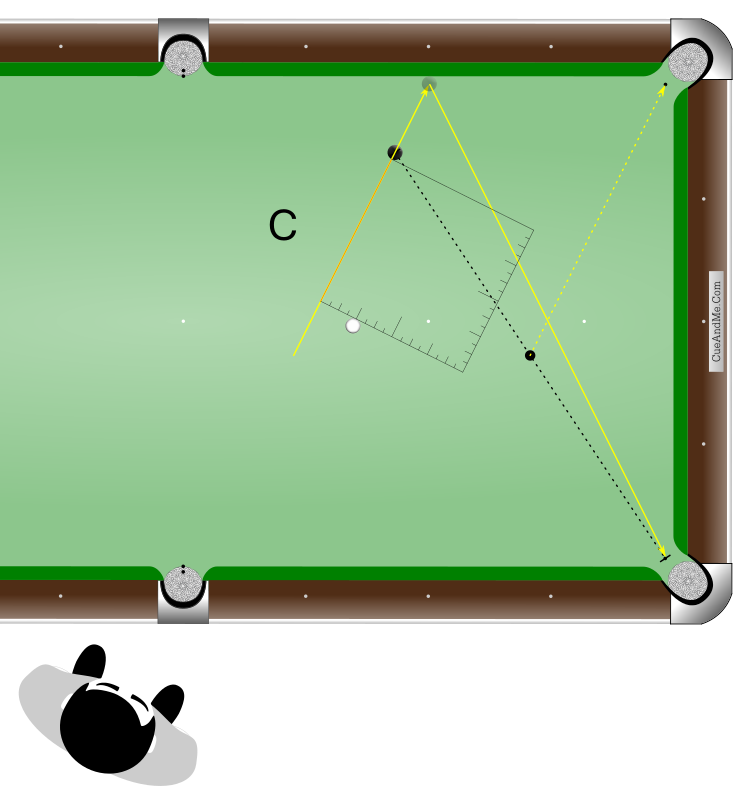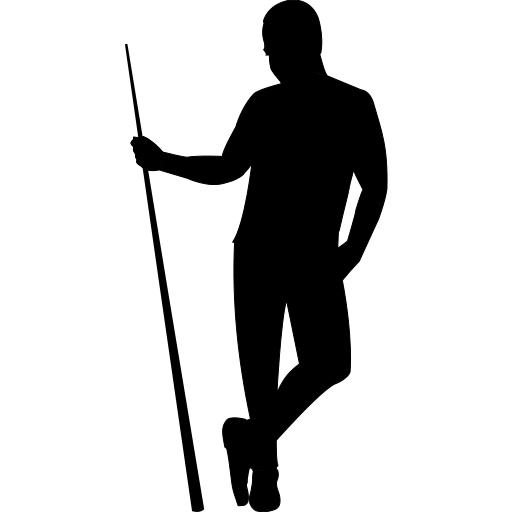Banks/Doubles
The bank shot in pool (or double in snooker) is a shot where the object ball is potted after first rebounding off of a cushion. Although theoretically the object ball’s rebound angle off of the cushion should mirror the angle of approach, spins and speeds can drastically alter it. Under most circumstances, the object ball rebounds at a shorter (more perpendicular to cushion) angle than the angle it approached the cushion. Slower speeds and “helping” spins can help to retain the mirrored integrity of the rebound angle. But we are going to begin this section by assuming a perfectly mirrored rebound angle.
It is beyond the scope of this release to teach an elaborate banking system. There are more detailed banking systems available from other instructors, so I encourage you to learn their methods. I will focus more on how to translate the Angle Detective methods already learned to a bank shot setup.
A bank shot is somewhat similar to a combination shot. In a combination shot, the destination of the first object ball is not the pocket but another object ball. Similarly, the first destination of the object ball in a bank shot is not the pocket but a position against a cushion. As we did with combinations, we will work backwards.
So let’s consider the bank shot to be a combination of two shots in one—a regular shot from cue ball to object ball and a “kick shot.” A kick shot in pool is one where the cue ball first rebounds off of a cushion before colliding with an object ball. For the kicking portion of our bank shot, the object ball will assume the cue ball’s kicking role—to the cushion first and then to the pocket. Although the object ball should strike a precise point on the cushion, we won’t concern ourselves with the cushion contact point. We will instead focus on the object ball’s direction of approach that creates a mirrored rebound angle that results in its return path toward the pocket.
Although the object ball should strike a precise point on the cushion, we won’t concern ourselves with the cushion contact point. We will instead focus on the object ball’s direction of approach that creates a mirrored rebound angle that results in its return path toward the pocket.
Position 1 Method
There are probably many methods for determining the object ball’s kicking direction into the cushion, but I will direct you to one that fits well with the Angle Detective system. Here are two short videos from The American Poolplayers Association YouTube channel where Tom “Dr. Cue” Rossman teaches his method for finding the object ball’s direction of approach to the cushion. The videos don’t address cue ball positions, but the line that Tom finds after moving his pool cue to hover over the object ball is the direction we are seeking for the kicking portion of our bank shot.
To summarize this method, first we find the midpoint between the object ball and the center of the target pocket. From this midpoint we then draw a line to the center of the opposite pocket. Maintaining this new line’s orientation, we drag the line until it is over the object ball. This becomes the object ball’s kicking direction into the cushion.
Once we are standing behind the object ball and facing in its kicking direction, we also happen to be standing perfectly in Position 1 to find the bank shot’s shot label. From here we simply apply Position 1 patterns as usual, using the resting positions of the cue ball and object ball to determine the shot label for the bank shot.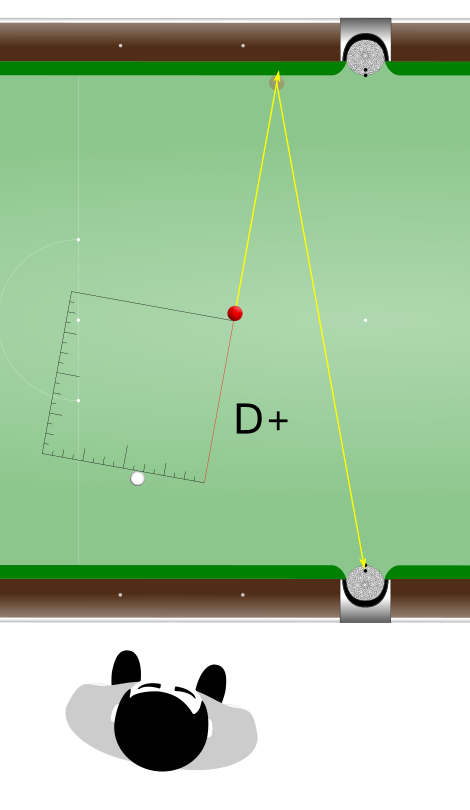
Once we know the shot label, we can ignore both the cushion and pocket and move to behind the cue ball to shoot the shot.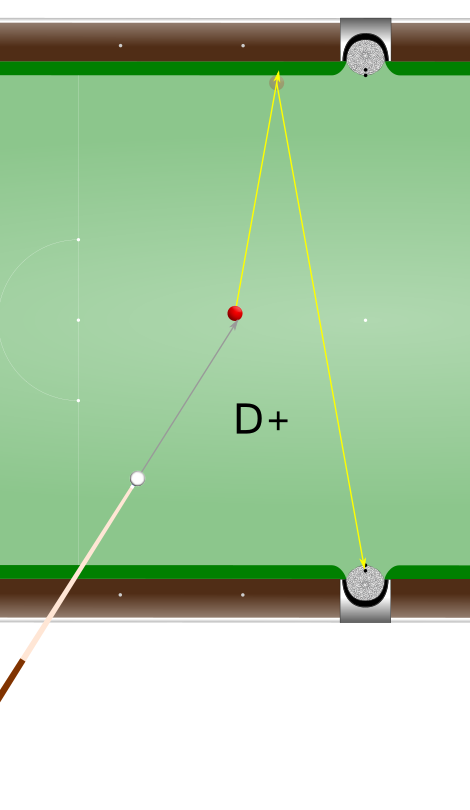
Position 1 Alternate Method
Another way to find the kicking direction is to imagine shooting the object ball to a distant pocket that lies beyond the table. For short banks, this imaginary pocket would lie one table width away from the center of the kicking cushion pocket. For long banks, this imaginary pocket would lie one table length away from the center of the kicking cushion pocket.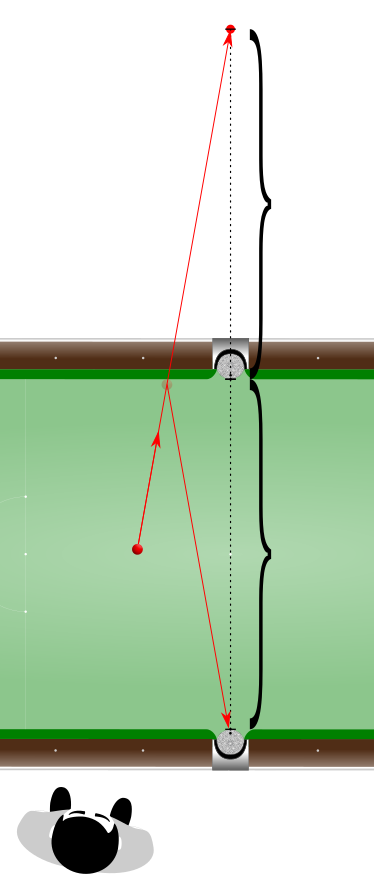
Once we have found the kicking direction we can remain where we are and apply Position 1 methods using the cue ball and object ball positions to find the shot label.
Position 4 Method
If you are fortunate to be playing on a table with a lot of walking space around it, there is an additional technique you may be able to apply. It is mainly for width of table bank shots off of the side cushions, since there would rarely be enough room to apply this technique to length of table banks off of the end cushions.
As we did with the Position 1 Alternate Method for finding the kicking direction, we will use the distance from the center of the target pocket to the center of the opposite pocket on the kicking cushion side of the table to locate Position 4. On a 9’ pool table this would be about 50 inches, and on a 12’ snooker table about 70 inches. Directly in line with both pockets on the kicking cushion side, stand so that you are this distance away from the center of the kicking cushion pocket.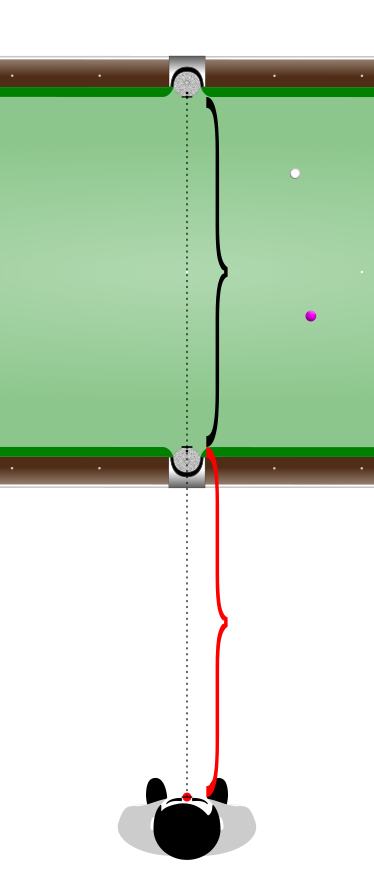 Now turn in place to face the object ball. You are now standing in Position 4.
Now turn in place to face the object ball. You are now standing in Position 4.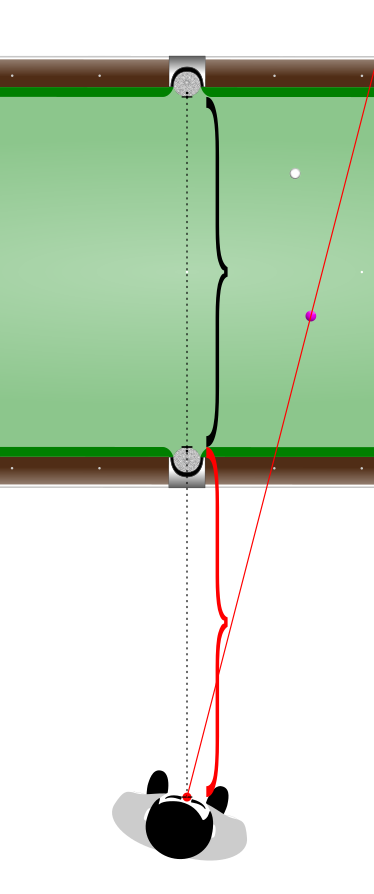
From Position 4, we are automatically facing the object ball kicking path. From this point forward we can ignore the cushion and pockets and simply apply Position 1-2 variation patterns using the object ball and cue ball resting positions. We can even get closer to the balls as long as we remain along this kicking path while walking.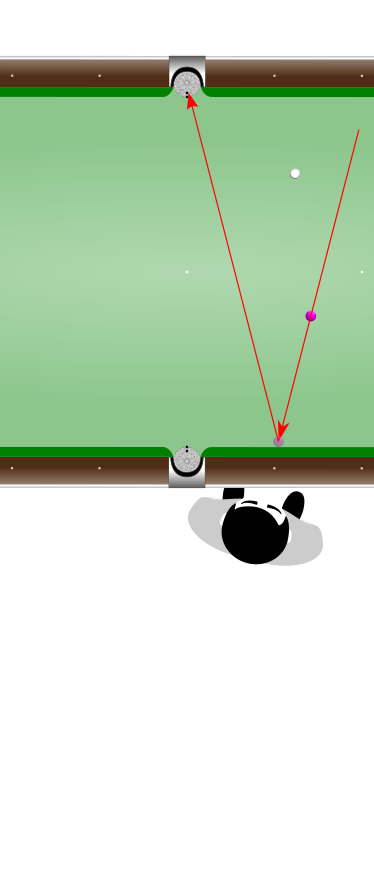
A length of table bank would require us to stand about twice as far away from the table, since the distance between a corner pocket and the other corner pocket along the same side cushion would be nearly twice the distance between pockets on opposite side cushions. This is why Position 4 would rarely be an option for lengthwise banks.
Adjustments
In the beginning of this section, I pointed out that perfectly mirrored angle geometry doesn’t normally apply. Different spins, speeds, playing conditions and table components can alter the rebound angle, making it nearly impossible to offer exact balancing adjustments that could return every bank to the perfectly mirrored geometry. Nonetheless, here are some general rules.
Speeds
The faster the object ball strikes the cushion, the shorter the rebound angle. To closer match rebound angle to approach angle, shoot more softly.
Spins
Draw a line from the cue ball through the object ball and beyond. Does this line intersect the eventual object ball rebound path line?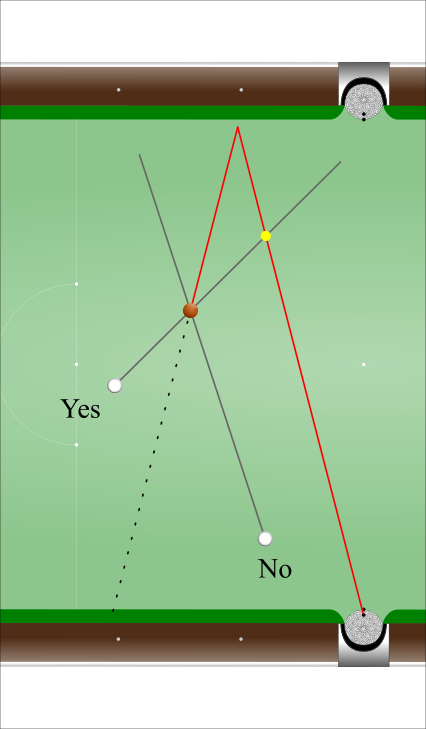
If yes, the cue ball will automatically impart a “helping” spin to the object ball that lengthens the object ball’s rebound angle. If no, the cue ball will automatically impart a “checking” spin to the object ball that shortens the object ball’s rebound angle. Therefore, on a helping bank shot your aim will be at or close to the shot label with little need for further adjustments. However, on a checking bank you will require an adjustment to a thinner shot label and/or helping cue ball spin to counter its angle-shortening effect.
Applying inside, outside, top or bottom spin to the cue ball can each have helping or checking effects depending upon the situation.
For a helping bank shot as described above, inside and/or bottom spin applied to the cue ball can potentially transfer to the object ball as helping side and/or top spin and can therefore lengthen its rebound angle even more. Conversely, outside and/or top spin can potentially transfer to the object ball as checking side and/or bottom spin and can therefore shorten its rebound angle, counteracting the inherent helping qualities of the helping bank shot setup.
For a checking bank shot, inside and/or bottom spin applied to the cue ball can potentially transfer to the object ball as checking side and/or top spin and can therefore shorten its rebound angle even more. Conversely, outside and/or top spin can potentially transfer to the object ball as helping side and/or bottom spin and can therefore lengthen its rebound angle, at least partially counteracting the inherent shortening qualities of the checking bank shot setup.


